
How To Transport a Kayak
With a kayak at your disposal, you can comfortably take your time away from home and enjoy the beauty of nature. This is the kind of boat that can help you explore virtually all waterways you can think of. Unfortunately, transporting it to the desired destination can be a little more difficult for some people. However, with the skills and necessary equipment, kayaking can become less bothersome.
Kayaks are made of different sizes and shapes with some as long as five meters. As such, you must prepare what you are going to use as well as get both your car and the kayak ready for the adventure. But, how do we even get started in the first place?.
How to get your vehicle ready for transporting the kayak
Table of Contents
- How to get your vehicle ready for transporting the kayak
- Ensure you have the following items, before loading the kayak
- It is easy to determine the best roof rack to buy having known the roof type of your car
- Soft racks
- Hard racks
- Rack Accessories
- Kayak cradles guarantee a comfortable secure transport of a kayak
- You can carry more than one kayak on your car using J-Racks
- Loading your kayak with assistance
- Loading your kayak alone
- How to safely fasten the kayak
- Driving safely with your kayak
Ensure you have the following items, before loading the kayak.
Roof Racks-They make it easier to transport the kayak. A strong roof rack helps prevent scratches on the roof of your car and bodywork of the boat. Depending on the type of your car, roof racks may occur in different versions. You can simply check the roof and confirm the type of your car racking system using this guide
Bare roofs- This is the kind of roof that does not have any point of attachment. You should not be worried only because your car has a bare roof. You can still transport your kayak with some of the available roof rack options. We will discuss a little more on that before the end of this guide.
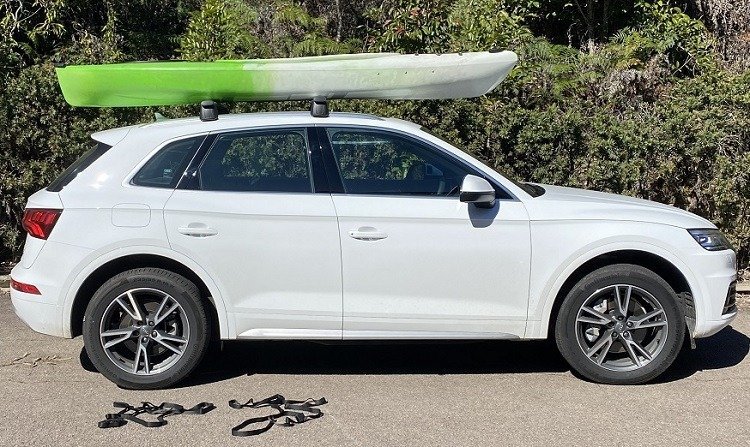
Side rails-The side rails of your car can either be raised or flush. Side rails have two rails that run parallel to the doors. The rail is not in direct contact with the roof so there will be a gap between the boot and the roof of your car. Flush rails are directly in contact with the roof. Nevertheless, both types of side rails offer satisfactory fastening and protection to your car and the kayak.
Gutters-On the top on your car doors on either side are ridges running the entire length of the car. Although they are not popular with modern cars, they offer excellent anchorage to the roof racks.
Fixed points – There are a set of four points of attachment concealed by plastic caps in the car. You just open the caps and bolt the roof rack system on them.
Tracks-These are slots running parallel to the door but on the outer edge of the car roof. Your car could have them already fixed by the manufacturer or you can install if your vehicle does not have them. The advantage of tracks is that you can remove the plastic covering and install a rack suited to your car.
Factory crossbars- These are crossbars installed on your car by the manufacturer.
It is easy to determine the best roof rack to buy having known the roof type of your car.
Soft racks are considered the best for vehicles that have bare roofs, fixed points, or tracks. Offering a simple yet safe transport for the kayak, soft racks can be made of foam or inflatable material.
You will see them as a pair of tubes with straps for fastening the boat. They are very easy to fix and remove with minimal storage space requirements.
Hard racks, also known as mounted crossbars are the ideal solution if your car has side rails, tracks, gutters, or fixed points. The disadvantage with these racks is that they are not conventional hence are available in different dimensions so you can choose the one that suits your car.
You can speak to one of our representatives on the chat function to help you make the right choice for a hard rack.
For long and safe kayak transit, a customized kayak holder or a mountable rack could be an ideal solution. For added stability, a proRack canoe or kayak holder kit comes in handy.
These ensure you can travel at high speeds without worrying over the kayak coming loose. They can be attached to tracks or on hard racks and crossbars
Kayak cradles guarantee a comfortable secure transport of a kayak.
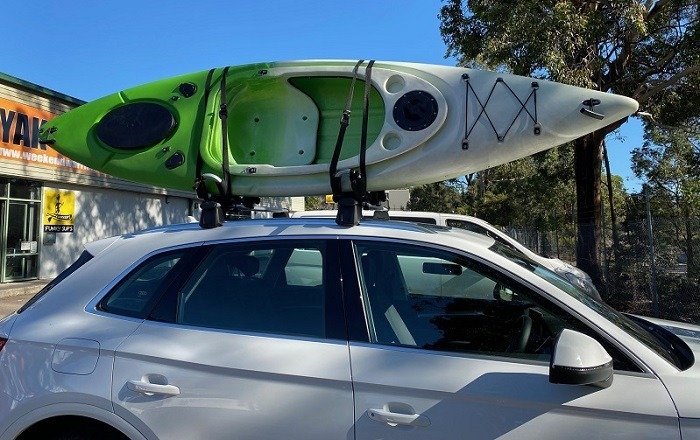
Alternatively, you may decide to use J-cradles. These hold the boat firmly on the sides which is suitable especially for plastic boats. If you want to protect your kayak from warping
it has to be on the roof for an extended period. Their folding mechanism when not in use helps to reduce air resistance while traveling. You can also find conventional folding cradles suited for several types of boats to adapt to changing preferences.
You can carry more than one kayak on your car using a J-folding cradle.
Loading your kayak with assistance
After finally assembling all that you need, you can now load your kayak with the help of another person. The boat should be placed with the bow toward the front and the stern on the back. Kayaks should be loaded upside down regardless of the racking system of your car, this is because of the shape of the kayak is often flatter on the top and sits better in this position. However, it should be placed right side up if you are using a kayak holder or cradle.
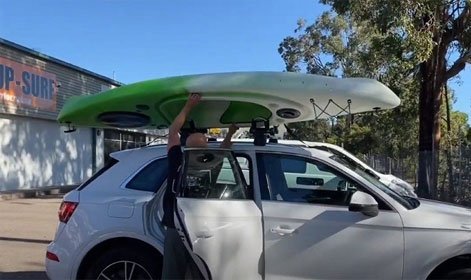
Loading your kayak alone
While loading a kayak alone may seem an impossible task, it becomes much easier with loading accessories. Although there are several load assists brands in the market, some are costly, difficult to use, or suited for a single racking system. Featuring a suction cup and a molded frame, the K-Rack Kayak Load Assist is an excellent choice to help you safely load the kayak.
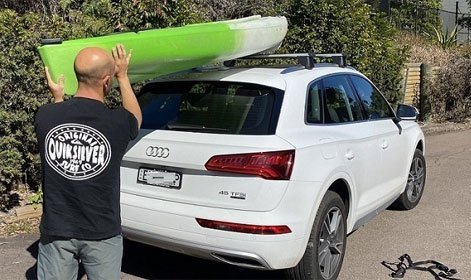
How to safely fasten the kayak
The next thing you do is to fasten the bow and the stern. Usually this is only required for longer kayaks, such as a sea kayak. This is done by tying the front handle of the kayak with a rope and securing it under the front bumper. Another rope is tied to the back handle of the boat and then fastened on the back bumper.
The main aim of these ropes is to keep the boat steady, therefore do not have to be tightened like the tie-downs.
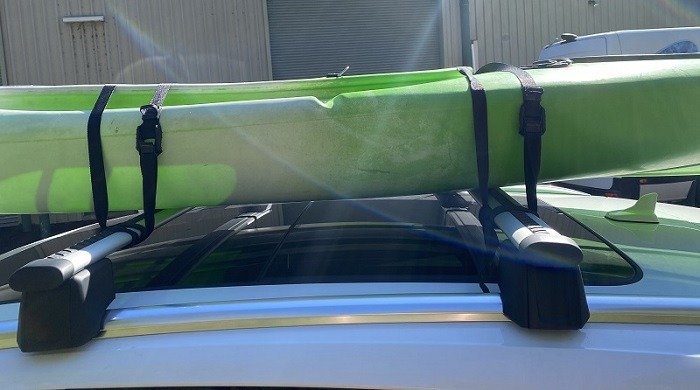
Using the tie-down straps, securely fasten your kayak ensuring you space up the tie-downs. If your car has the hard racks, fastening the straps within the fixture prevents sliding of the kayak. On the contrary, soft racks, for example the Sea to Summit Soft Roof Rack have points of attachment to fasten tie-downs.
After ensuring the tie-downs are tight enough, check that no part of the boat is warped. Fastening too tightly may press upon the boat causing damage. Just ensure that the boat is securely fixed and does not move the slightest.
Make a final check by going around the vehicle checking that everything is in the desired order. It is also crucial to recheck the vehicle if you leave it loaded before finally leaving for the adventure.
Driving safely with your kayak
Having secured everything with you are about to embark on your journey, there is one more thing to check. Ensure your car tyres have enough pressure and you can use your vehicle handbook to adjust it accordingly. Always ensure you keep distance while on the road. If you are traveling for a long distance, make occasional stops to confirm everything is okay. The worst can happen should fastenings go loose. Don’t just be eager to arrive and forget to be a little more cautious or else you may never make it with your boat intact.
Are you looking for the best kayak transport solution or even queries? We are happy to answer any questions you may have by phone or email at [email protected]


















